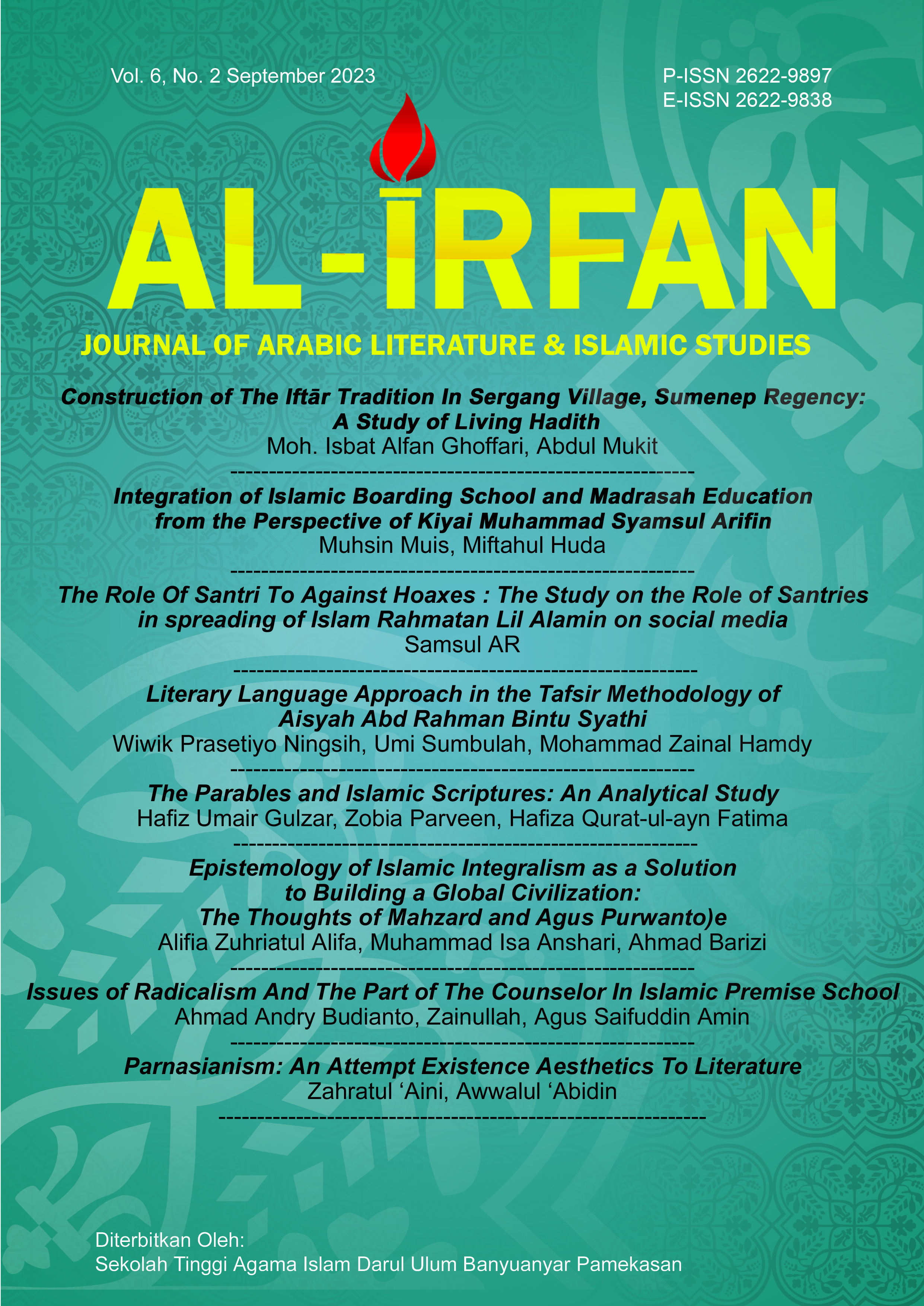The Parables and Islamic Scriptures: An Analytical Study
Parables in the Quran
DOI:
https://doi.org/10.58223/alirfan.v6i2.6736Keywords:
Parables, Quran, Hadith, Sufi LiteratureAbstract
Allah the Exalted is the only Lord of all the worlds. He has sent Prophets and Messengers in all periods to guide mankind. He has also revealed Divine Scriptures to edify mankind. Several Manuscripts and Books were revealed on different Prophets. The Qur’Än is the last and final word of Allah towards humanity till the Day of Judgment. The Qur’Än teaches humanity about the Unity of Allah, the love and obedience of Prophet Muhammad PBUH, methods of worship, and many more. In the Qur’Än, different unique methods have been adopted for the purpose of guidance e.g. literary method, psychological, interrogative, method of telling a story of past times, etc. The parabolic form is one of these methods. This article analyzes the significance and details of the illustrative method. It is the convention of Allah to teach through this method. The Apostles of Allah have also adopted this method to preach the word of Allah in an easier way.References
Ibn al-FÄris, Aḥmad, AbÅ« al-Ḥasan, Mu’jam MaqÄyÄ«s al-Lughah, DÄr al-Fikr, Beirut, 1979, vol. 5,
ZamakhsharÄ«, MaḥmÅ«d b. ‘Amr b. Aḥmad, AsÄs al-BalÄgha, DÄr al-Kutub al-‘Ilmiyya, Beirut, Lebanon, 1998 vol. 2
Ibn Taymiyya, Aḥmad b. ‘Abd al-ḤalÄ«m, Majmū’ al-FatÄwÄ, IdÄrÄt al-Baḥūth al-‘Ilmiyya, al-Riyaz, Saudia, 1978, vol. 14,
Jawziyya, Muhammad b. AbÄ« Bakr AyyÅ«b Ibn Qayyim, al-AmthÄl fi al-Qur’Än, DÄr al-Ma’rifa, Beirut, 2000,
BayhaqÄ«, Aḥmad b. al-Ḥusayn, Shu‘ab al- á¿™mÄn, Book, Fi Qir’Ät al- Qur’Än bi TafkhÄ«m wa al-I‘rÄb, h. # 2293.
ḤÄkim, Muhammad b. ‘Abd AllÄh, al-Mustadrak ‘Ala á¹¢aḥīḥyn, Book, Faá¸Ä’l al-Qur’Än, Chapter, AkhbÄr fÄ« al-Faá¸Ä’l al-Qur’Än, h. # 2031.
al-QatÄn, ManÄ b. Khalil, Mubahith fil ‘UlÅ«m al-Qur’Än,
Imam HÄfiz AbÅ« ‘ῙsÄ Muhammad Ibn ‘ῙsÄ al-TirmidhÄ«, JÄmi‘ al-TirmidhÄ«, Translated by Abu KhalÄ«l, Maktaba DÄr-us-SalÄm, 2007, vol. 5,
Ḥanbal, Aḥmad, Musnad Aḥmad bin Ḥanbal, Maktaba DÄr al-Fikar, 2007, VOL. 6 h. #.
Ibn Kathir, AbÅ« al-FidÄ’ IsmÄ‘īl b. ‘Umar. TafsÄ«r al-Qur’Än, Beruit: Dar al-Fikr, VOL. 4
SiyÅ«á¹Ä«, JalÄl al-DÄ«n, ‘Abd al-RaḥmÄn, al-ItiqÄn fÄ« ‘UlÅ«m al-Qur’Än, DÄr al-Fikr, Lebanon, 1996, vol. 4
Morteza, Afshari, Study of Mental Imagery in the Parable of the Qur’Än with Emphasis on the Function, The Turkish Online Journal of Design, Art and Communication, NO: 10.7456/1060NVSE/086, (November 2016),
Tahir-ul-Qadri, Dr., DurÅ«s MtahnawÄ«, Biography of MawlÄnÄ RÅ«m Methodology of MathanawÄ«, Lahore Lecture # Fn-10, 7 June, 2018, Itikaf City.
Tahir-ul-Qadri, Dr., Qur’Änic Encyclopaedia, Minhaj-ul-Qur’Än Publications, Manchester, 2019, vol. 3,
Ibn al-Qayyim, Paragons of the Qur’Än,
TirmidhÄ«, JÄmi‘ al-TirmidhÄ«, Vol. 5, Book 42, Hadith 2874
Lose Colendrino & Manuel R. Guerrero, 1993, Introduction to Psychology, Rex printing company, pp.
Ibn ‘ArabÄ«, Muḥy al-DÄ«n, al-FatūḥÄt al-Makkiya, DÄr al-Kutub al-Ilmiyya, Lebanon-Beirut, 1970, vol. 1,
Downloads
Published
How to Cite
Issue
Section
License
Copyright (c) 2023 Hafiz Umair Gulzar, Zobia Parveen, Hafiza Qurat-ul-ayn Fatima

This work is licensed under a Creative Commons Attribution 4.0 International License.
Lisensi :
Al-Irfan: Journal of Arabic Literature and Islamic Studies is published under conditions Creative Commons Attribution 4.0 International License / CC BY 4.0 This license permits anyone to copy and redistribute this material in any form or format, modify, modify, and make derivative works of this material for any purpose, including commercial purposes, so long as they credit the author for the original work.











